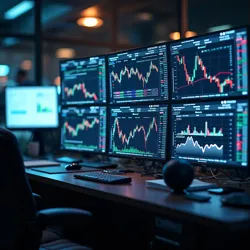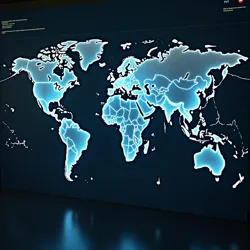Visual Territory Futures
 A high-frequency trading terminal displaying real-time visual territory futures contracts and market analytics
A high-frequency trading terminal displaying real-time visual territory futures contracts and market analyticsVisual Territory Futures represent a sophisticated financial market that emerged in the mid-2030s, allowing investors and corporations to trade contracts based on future rights to exploit visual attention spaces. This market developed as a direct response to the increasing scarcity of premium advertising surfaces following the First Attention Wars and has since become one of the most dynamic sectors of the modern attention economy.
Market Structure and Operations
The Visual Territory Futures market operates through a complex network of digital exchanges, with the Global Visual Exchange (GVX) in Neo Singapore serving as the primary trading hub. Contracts typically specify precise geographical coordinates, temporal windows, and attention quality metrics for visual spaces ranging from traditional urban surfaces to more exotic locations such as low-orbit atmospheric displays and biomedical imaging systems.
Trading in these markets requires sophisticated understanding of multiple factors, including seasonal attention patterns, demographic shifts, and technological advancement trajectories. The introduction of Neurometric Valuation Standards in 2039 revolutionized the way future visual territories are assessed, incorporating advanced brain-tracking data to predict the potential attention capture rate of different spaces years in advance.
The market's complexity has led to the development of specialized financial instruments, including Visual Space Swaps and Attention Deficit Insurance, which help traders manage risk and optimize their visual territory portfolios. These instruments work in conjunction with traditional Attention Derivatives to provide a comprehensive framework for speculating on future attention value.
Technical Infrastructure
 The GVX's primary neural prediction array used for calculating future attention values
The GVX's primary neural prediction array used for calculating future attention valuesThe technological backbone of visual territory futures trading consists of advanced predictive systems that combine artificial intelligence, neurological monitoring networks, and environmental sensing arrays. The Atmospheric Commerce Institute maintains a global network of sensors that track everything from weather patterns to population movement flows, providing crucial data for futures pricing.
These systems employ sophisticated modeling techniques developed by the Predictive Attention Sciences Institute, which can forecast visual attention patterns up to fifteen years into the future. The models account for factors such as architectural developments, demographic shifts, and anticipated changes in human attention spans due to evolving Neurological Impact from various attention-capturing technologies.
Market Participants and Strategies
Major players in the visual territory futures market include traditional advertising conglomerates, technology corporations, and specialized visual space investment firms. The emergence of Attention Space Arbitrage as a trading strategy has attracted numerous quantitative trading firms, who employ advanced algorithms to exploit price discrepancies across different temporal and spatial dimensions of visual territory contracts.
Institutional investors have increasingly turned to Visual Territory Futures as a hedge against traditional market volatility. The correlation between visual attention value and economic activity has made these instruments particularly attractive during periods of financial uncertainty. This has led to the creation of specialized Visual Real Estate Investment Trusts that focus exclusively on future attention space acquisition and development.
Regulatory Framework
The regulation of Visual Territory Futures falls under the jurisdiction of the Global Attention Rights Commission, which establishes trading rules and oversight mechanisms for the market. The commission's Visual Futures Trading Act of 2038 established the fundamental framework for contract standardization and market participant requirements.
Key regulatory concerns include the prevention of attention space monopolies, protection of public visual commons, and the maintenance of market stability. The Visual Commons Protection Act places specific restrictions on the types of spaces that can be traded in futures markets, with particular emphasis on preserving certain cultural and natural visual environments for public benefit.
Social and Economic Impact
The development of Visual Territory Futures has fundamentally altered the landscape of urban development and public space management. Cities and municipalities now routinely factor future attention value into their development plans, leading to the emergence of Attention-Optimized Architecture as a dominant design paradigm.
The market has also influenced the development of new technologies, particularly in the realm of Mixed-Reality Advertising Spaces. Companies frequently use futures contracts to secure rights to virtual and augmented reality spaces years before the necessary display technologies become available, driving innovation in the sector.
Challenges and Controversies
The Visual Territory Futures market has faced significant criticism from various quarters, particularly regarding its impact on public space and social equality. The Right to Visual Silence movement has consistently opposed the commodification of future visual spaces, arguing that it infringes on fundamental human rights to unmediated visual experience.
Technical challenges include the difficulty of enforcing futures contracts in rapidly changing urban environments and the complexity of valuing attention spaces in the context of evolving technology. The emergence of Neural Blocking Technologies has created particular uncertainty in the market, as these systems potentially threaten the future value of traditional visual territories.
Future Developments
Industry analysts predict continued evolution of the Visual Territory Futures market, particularly as new technologies create novel forms of visual space. The development of Biophotonic Integration systems and advanced neural interfaces is expected to create entirely new categories of tradable future attention spaces.
The integration of Emotional Resonance Optimization techniques into futures pricing models represents a significant frontier for the market, potentially allowing for more accurate valuation of future attention spaces based on their emotional impact potential rather than purely visual characteristics.
See Also
- Attention Space Derivatives
- Visual Territory Mining
- Futures Contract Enforcement Technology
- Temporal Attention Rights
- Spatial Consciousness Markets
References
- Institute of Future Attention Economics, "Annual Report on Visual Territory Markets" (2042)
- Global Visual Exchange Trading Guidelines, 15th Edition
- Journal of Attention Space Economics, Volume 24, Issue 3